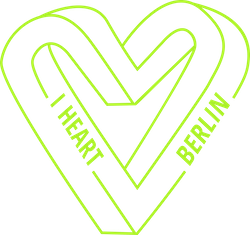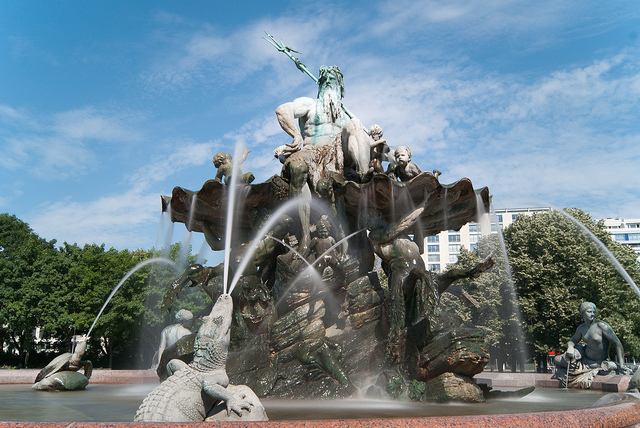What is the essence of a city? What is Berlin made of? As we already established, it is mostly made of the people inhabiting it. Berlin is a concrete jungle, with many beautiful buildings. Old architecture and new people mix well. They flow through the city like water in the canals. Water is life, water pulsates, water is the substance we are made of. And there is a lot of this substance in a metropolis like Berlin. Next to the Spree and the seas of the capital, there are other springs of water: Fountains. All over the capital you will find those sometimes grandiose, sometimes simple water oases.
But they are always architectural masterpieces, relics of other times, loaded with history and symbolic meanings. But they are also places to rest and dwell. On fountains, people who don’t know each other come together, people who have a date, people who are alone.
See ten of our favorite water places in Berlin and get some inspiration to plan your next walk in the city. Right after the jump.
Stag Fountain
The most impressive fountain is located in Schöneberg in the Rudolph-Wilde-Park. Its glory comes courtesy of the golden stag statue atop a high column. Designed by August Gaul in 1912 the stag is not chosen at random – it is the emblem of the district Schöneberg (much like the bear is the chosen symbol of Berlin).
photo: Wolfgang Scholvien © visitBerlin / CC
Ages of Life Fountain
The Lebensalterbrunnen is one of two fountains at Wittenbergplatz and is located at the South part of the square. Both of them were designed by Waldemar Grzimek in the early 80s. As the name suggests the sculptures of the people of different ages represents the different stages of life. With the openness of the fountain structure and the joyful depiction of life it was supposed to be a relatable piece for the people of Berlin.
photo: Oh-Berlin.com / CC
The Levitating Ring
The huge fountain in the middle of the roundabout at Straußberger Platz in Friedrichshain was designed by Fritz Kühn in 1967. The seemingly levitating circle of structured copper plates combined with the game of lights and water give this fountain a certain sense of velocity that reflect the surrounding traffic.
photo: Jean-Pierre Dalbéra / CC
The Neptune Fountain
The magnificent Neptune Fountain was originally designed by Reinhold Begas in 1891 and used to be located in front of the castle. The war pretty much destroyed it, but it was rebuilt in the 70s in front of the red town hall where it still stands today. The four women statues surrounding the fountain originally symbolized the rivers Rhein, Elbe, Oder and Weichsel.
The Fountain of the Friendship of the People
The most popular fountain in our list is the one at Alexanderplatz, designed by Walter Womacka in 1970. The white doves, butterflies and flowers symbolize peace and the fact that it’s surrounded by benches where people from all over the world sit next to each other emphasizes its title “Friendship of the Peoples”.
photo: John Menard / CC
Schiller Fountain
The statue in the center of the Gendarmenmarkt in honor of the 100th birthday of Friedrich Schiller actually doesn’t seem like much of a fountain. But if you look closely you see the small basins at the foot of the column that the four characters are sitting on. Between them you see the typical lion heads where the water used to come out. The fountain was designed by Reinhold Begas and finalized in 1871. For a long time all of its parts were separated and spread out all over town. But in the mid 80s it was reunited and reconstructed in the middle of Gendarmenmarkt, though its function as a fountain was abandoned, unfortunately.
The Wall Fountain
This fountain is the newest one in our list. It clearly symbolizes the fall of the wall, or more accurately the sinking of the wall. It was designed by Christoph Girot and opened in 1997.
The Indian Fountain
The Indian fountain inside the rose garden of the former Luisenstädtischen Kanal has quite an interesting history. The canal used to connect the Landwehrkanal and the Spree from 1852 onwards. In 1926 the canal was closed and filled up except for the Engelbecken. During the time of the separation the wall went along the former canal. In the mid 90s the remains of this fountain were discovered in the ground and as part of the transformation of the area into a park it was rebuilt in 1995.
The Fairytale Fountain
One of the most beloved fountains in Berlin is the so called Fairytale Fountain in the Volkspark Friedrichshain. It was built in the early 1900 by Ludwig Hoffmann and is in the style of Neo-Baroque. It was not just a fountain but also a garden that is located behind it. The entire complex includes over 100 scultptures and depictions of different fairytales, 9 of which were by the Brothers Grimm.
The Bull Fountain
The bull fountain does not only stand out by its striking red color, but also by its big size. Built in the 30s by Hermann Leder its original name “The Fountain of Fertility” gives it a lot of symbolic meaning. The statues underneath the prominent pair of bulls explain what kind of fertility is meant here, not just the fertility of men, but also of farm animals, of crops and of fishes, as there is a mother with a child, a shepherd with a ram, a farmer with his corn and a fisherman with fish.
photo: Eylül Aslan
We hope you enjoyed our little selection and are curious to know if you know any other nice fountains in Berlin that we should take a look at! Let us know in the comments below.










